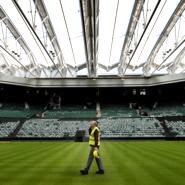10. FABIO CAPELLO (down):
Not content with blaming the WAGs for England's 44 years of hurt, killjoy Capello now believes New Order, Frank Skinner and the bass player from Blur have held key roles in the conspiracy. Yes, there will be no World Cup song because "we want to be fully focused on football". Never again will we see John Barnes rapping or Mooro and the boys fiddling with their dickie bows and nervously averting their eyes from Pan's People. We believe this England side should express themselves by recording an album of Leonard Cohen covers. The game's gone.
9. SKIERS (down):
Inevitably that they should be going downhill really, the British ski team heads off to the Winter Olympics next month with their national federation on the verge of collapse. Cue doubts about funding and jobs and whether they will even be allowed to compete.
Wayne Rooney's metatarsals have better timing.
8. DAVID ATTOUB (down and out):
The Stade Francais prop has been given a 70-week ban for gouging. Club president Max Guazzini blamed an "anti-French bias" and pointed out Springbok Schalk Burger got eight weeks for the same offence, which admittedly is better than a poke in the eye. Attoub, a man possessing the look of an outtake from The Sopranos, has previous. Gouging is abhorrent, even in a sport that is based upon cheating. It is not sure what he will do during his absence, but he is said to have his finger in several pies.
7. ANDREW STRAUSS (down):
Funny old game cricket. With a face made for widescreen TV, the England skipper was previously the toast of the nation, steering Ashes heroes to the cusp of a Test series triumph over nasty South Africans and being in the shake-up for BBC Sports Personality of the Year. Then he oversees a water bed resistance and decides he does not much fancy taking on Bangladesh.Sports Watch notes that even Captain Bligh turned up.
6. OWEN COYLE (down):
One of the first rules of sport is to whinge when you're winning. Anything else comes across as sour grapes. Hence, while Coyle was right to damn the ever-irritating William Gallas for his "assault" on Mark Davies, he should have kept his counsel, even had the Frenchman stuck the midfielder in his boot, driven to the docks and fed him to the fishes, while The Shangri-Las sang Remember (Walking in The Sand), a la Goodfellas, to the backdrop of a crimson sunset. Of course, should Kevin Davies maim someone next week, the moral outrage will be replaced by Wenger-esque myopia.
5. TIGER WOODS (non-mover):
Reports surfaced this week that the world's greatest golfer had checked into a clinic specialising in sex addiction. You should never judge a book by its cover or a bloke by his undercover activity, and the critics can no longer see Woods for the trysts. A fallen hero perhaps, but the only man able to make golf watchable. As for sex addiction clinics, that sounds like an expensive way to give medical credibility to an inability to keep one's pants on.
The case continues.
4. RAFAEL BENITEZ (up):
We love Rafa here. Says the Spurs game is make or break. Says he can guarantee the top four. That American chap says he is one of the top five managers in the world. People laughed at that one, but when you start compiling names he would certainly make many a top ten. The conundrum is this: is it managerial greatness to see off Spurs with such a modest team or is it managerial ineptitude that means you have such a modest team in the first place? Whatever, Liverpool will finish fourth. Largely because Spurs are not very good either and Villa can let in four at home to Blackburn.
3. EOIN MORGAN (new entry):
It is IPL auction time, that bizarre mix of Bollywood and Bargain Hunt. Morgan was the only English (Irish) cricketer to be picked in the auction for a whopping fee of £135,000.
And the beauty of the IPL is he will hardly have to play for his money as the likes of Jacques Kallis and Kevin Pietersen are in the line-up ahead of him. The best money-spinner this side of suing Portsmouth for your image rights.
2. JAMES MILNER (up):
Regular readers here will know we bow to no man or woman in our appreciation of helium-based tattoo king David Beckham, but we are warming to Milner. Like Beckham he is devoid of pace, but he is refreshingly direct, does the simple things well and plays with a rare degree of common sense. Fundamental to Villa's rise and knocking on the door for South Africa.
1. GARY NEVILLE & CARLOS TEVEZ (new entry):
Obscene gesture? Neville raised a finger. Come on, this is the sanitising of football run amok and ignores the sheer fun of the spat between the former colleagues. We particularly like Tevez's description of Neville as a "moron", although "boot-licker" was pithy too, and feel players should be encouraged to express their feelings with such candid colour. Neville, never one to be confused with Charlie Cairoli, is now turning into the angriest of old men, like an anaemic Hulk with middle-age spread. Expect the sparks and Ovaltine to fly in the second leg next week.










